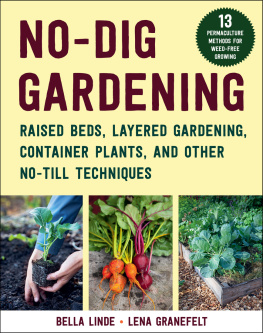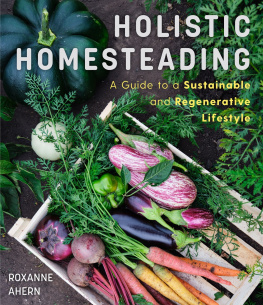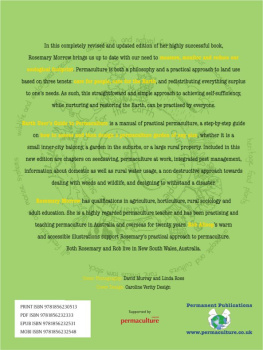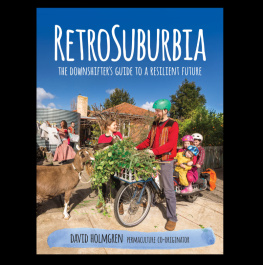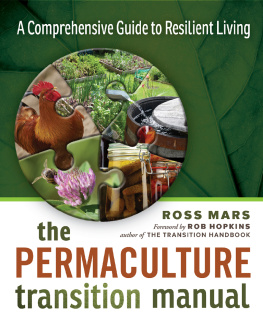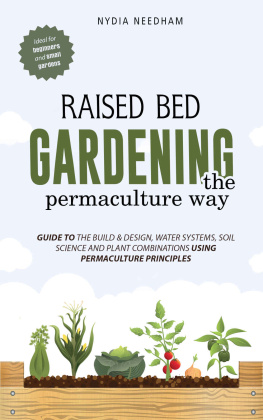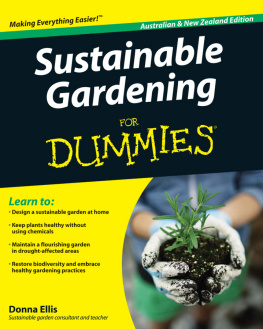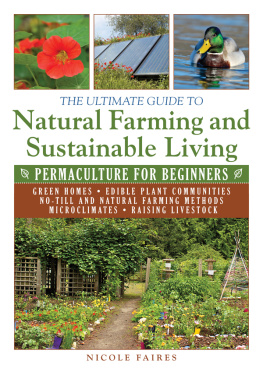This book is dedicated to mystrongest source of support, my parents.
Chapter1- Permaculture- A BriefHistory
Permaculturecan be thought of both as a concept and as a copyrighted term or perhaps atrademark. The concept is certainly not new. In pre-Columbian times much ofboth North and South America was in carefully managed forest agriculturecommunities with virtually all aspects of life designed to foster a sustainablelifestyle.

Untilthe growth of feudalism parts of Europe practiced sustainable lifestyles.Similar practices existed in Sri Lanka and Tanzania. By the 19th Century manyAmerican philosophers and religious teachers were advocating sustainablelifestyles. In the desert regions of the Middle East and Africa houses havelong been built to utilize solar energy to power ventilation for cooling andstore heat for night time heating.
In1929 Joseph Russell Smith used the term Permanent Agriculture in the subtitlefor his book Tree Crops: A Permanent Agriculture. By the early 1970's BillMollison and his student David Holmgren began publishing books and chapters onwhat they called permaculture. At this time Mollison claimed copyright on theterm. Eventually it was realized that the term could not legally becopyrighted. Attempts to trademark or service mark the term has also failed.This development allows more people to use the term. Although this can benefitby allowing wider input into the movement, it also makes it possible for rightwing opponents of ecological interests to use the term for concepts designed toprofit from destroying the environment.
Theinfluence of Holmgren on the work of Mollison is important because of hisinterest in design, particularly landscape design. In the early 1970s the twoof them collaborated to develop an interdisciplinary earth science. At thistime Holmgren was studying environmental design at Tasmania's EnvironmentalDesign School and Mollison was teaching environmental Philosophy.
Tasmaniais a place where the modern world and nature collide. The intellectual fermentof the 1970s produced environmental movements all over the world at that timeand the movement born in Tasmania flourished to produce Permaculture.Permaculture made its international appearance in 1976 through an article inTasmania's Organic Farmer and Gardener newsletter in an article by Mollison andHolmgren titled A Permaculture System for Southern Australian Conditions.
MaxLindegger read the chapter and started the second permaculture group at hishome in Queensland in 1976 and went on to found the first permaculture Ecovillage, Crystal Waters. Max described this as "an electrifyingtime".
Thefirst book on the subject, Permaculture One -a Perennial Agriculture for HumanSettlements, co-authored by Mollison and Holmgren was published in 1978 Thefirst permaculture magazine also appeared that year. It was simply titledPermaculture.
Thiswas a time that was ripe for virtually any ecological movement. The time ofcheap energy derived from fossil fuels was beginning to end and concerns aboutthe greenhouse effect were beginning to be expressed by intelligent people.Concerns about the wholesale use of toxic chemicals had been around for sometime and continued to grow.
In1987 the publication of the Permaculture magazine was handed over to RobynFrancs and was moved to Sydney. It became known as the PermacultureInternational Journal. In 1986 the second international conference onPermaculture was held in Washington State in the United States, proof that themovement had become international.
Themovement had taken hold in many countries by the turn of the century. Althoughit has become influential in many countries one of the most interesting placesit has become influential is Ireland, a country that understands all too wellthe foolishness of monoculture of non-native crops. It is interesting to notethat the Irish group emphasizes that Ireland once had many forest based farmsand villages. Much of the agricultural model for permaculture is based on theforest gardening concept.
ThePermaculture movement continues to be strong in America. As long as it iswilling to grow in its intellectual model and does not fall into the trap ofbeing dogmatic about any one interpretation of the basic concept it willcontinue to be influential. Because the initial work by Mollison and Holmgrenlaid out a specific formula in the form of enunciated principals it would beeasy for dogmatic followers to fall into that trap. Hopefully the fact that theearly movement was so open to debate and the ability to adapt to different situationswill allow it to continue to grow.
Oneof the leaders of the permaculture movement in Australia is Rosemary Morrow.She has been quoted as saying that she views permaculture today as being aprototype. She points out that the movement is barely 30 years old. Othercommentators remember that the principles are much older. The movementoperating under the name Permaculture is based upon a formalization of relatedconcepts into a particular intellectual discipline. By emphasizing that it ispossible to combine a variety of lifestyle principles to further the goal ofthe long term survival of the Human race in a healthy and comfortable way t maybe possible for people to realize that goal.
Itis interesting to note that Holmgren has laid out twelve principles forPermaculture. Alcoholics Anonymous has a twelve step program for recoveringalcoholics to follow. More than one environmentalist has compared thedependence on non-renewable resources such as petroleum to drug addiction.
Thefuture of the general green movement does not depend on the success of any onegroup in the movement, but as one or the other group grows in influence if itkeeps in mind that the goal is the survival of mankind and not the survival ofany one organization success for the movement is likely. Permaculture seems tounderstand that. The basic ethical principles of Permaculture are in line withthat concept.
Chapter2- The Benefits of Permaculture
Permacultureas a farming practice has been widely adopted by many farmers across the world.The practice applies the principles of agro-ecology in order to maximize thefood production while effectively utilizing the limited resources. It also aimsto create sustainability of the people and enriching their lives. It tries tocorrect the environmental problems brought about by industrialization.


